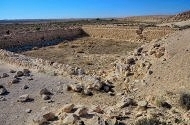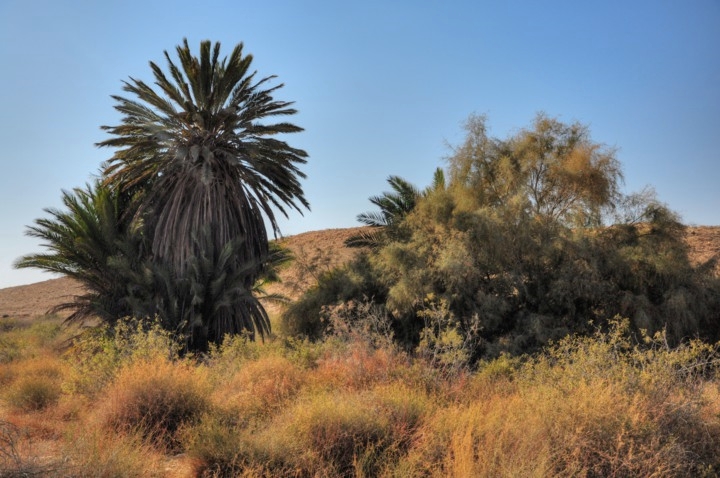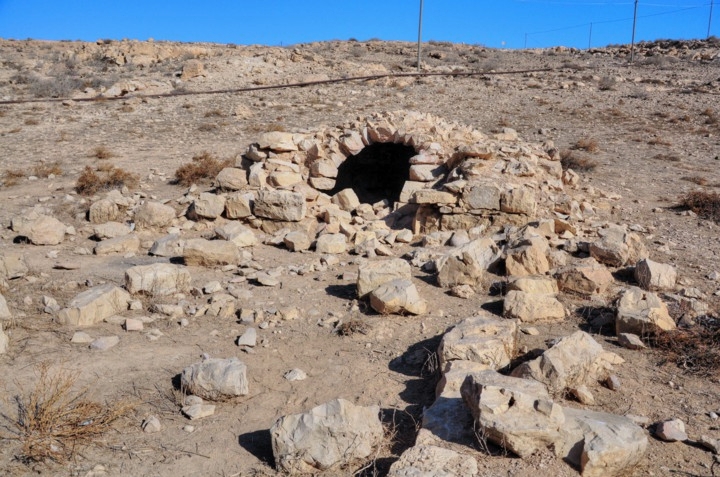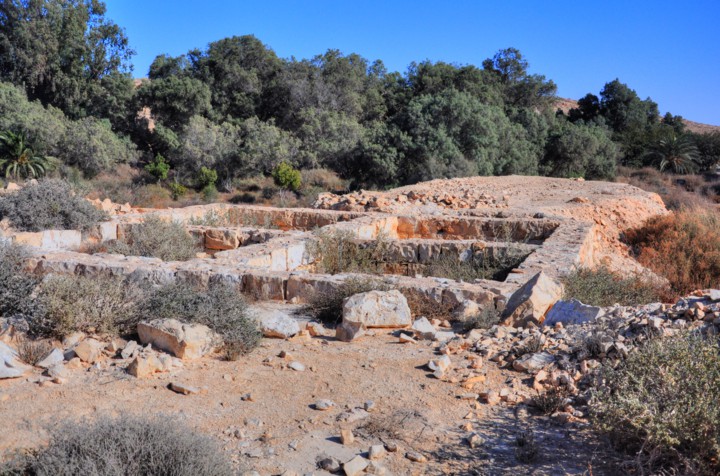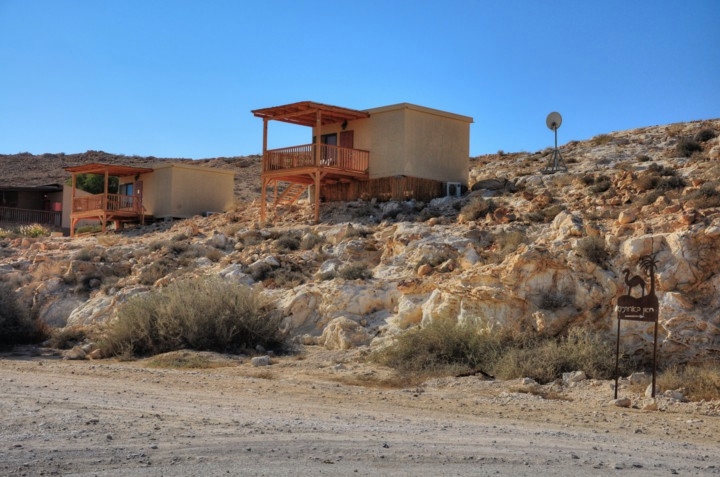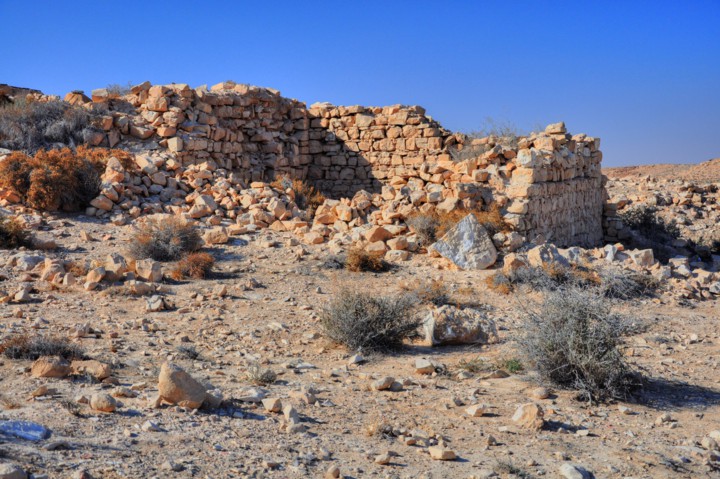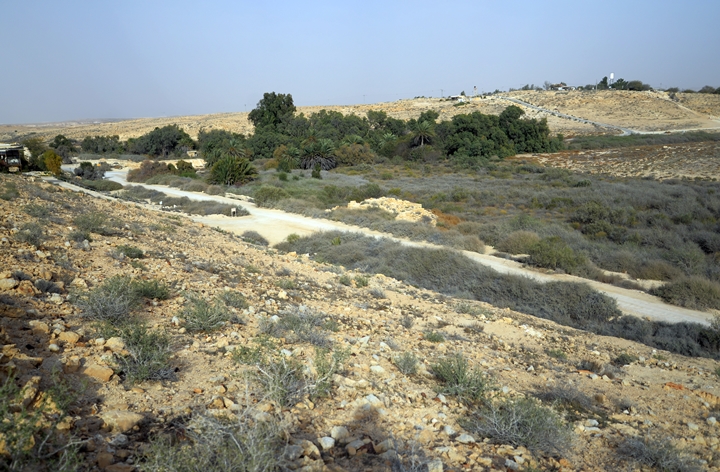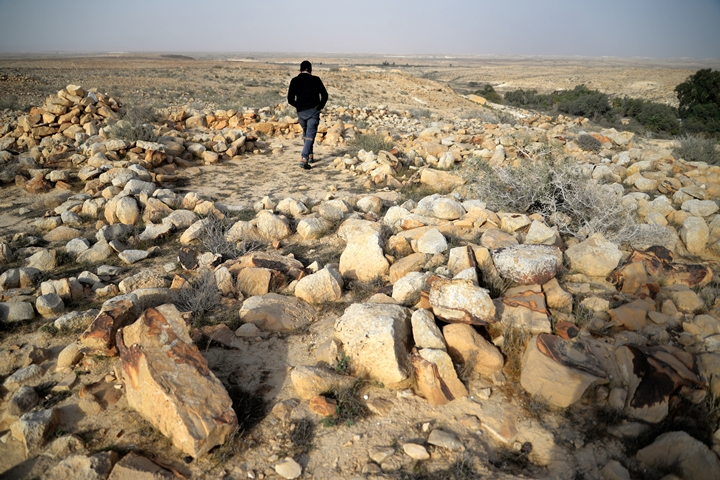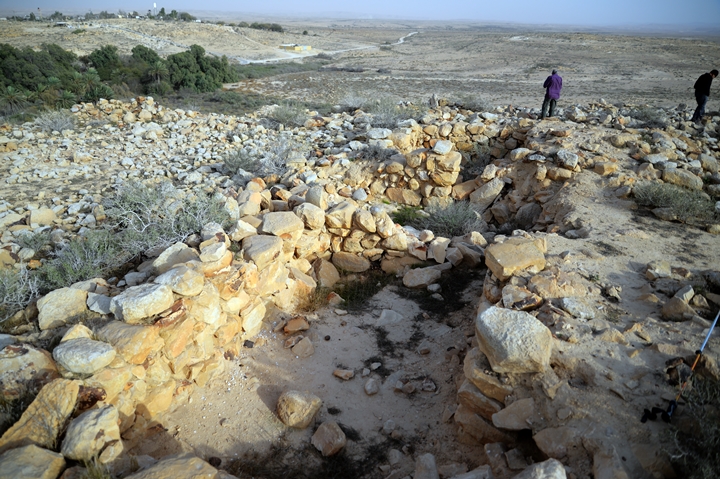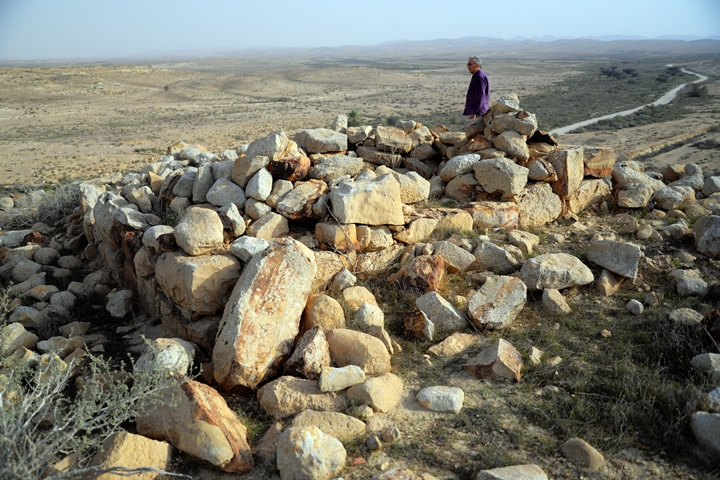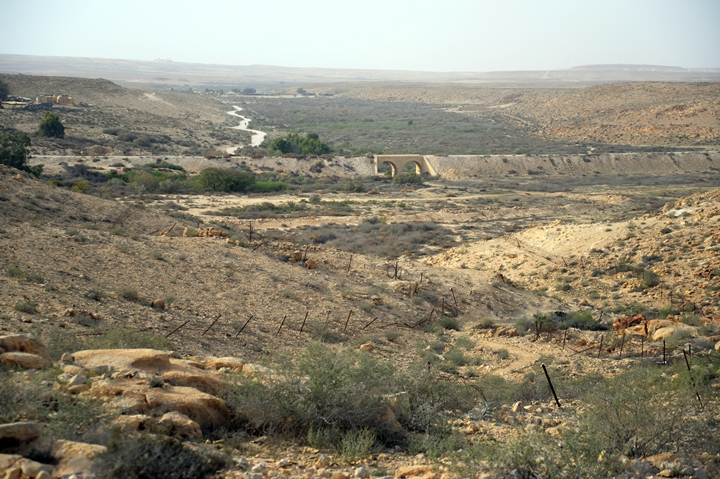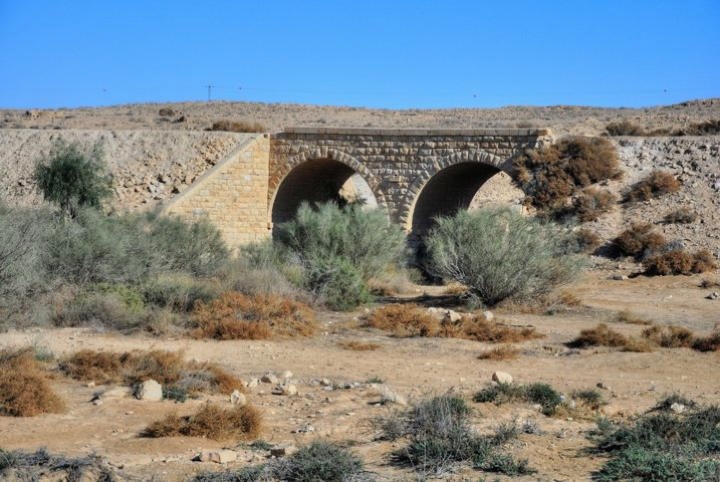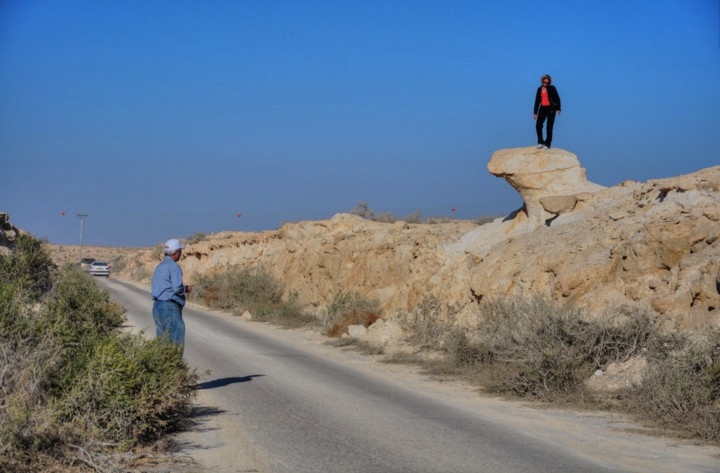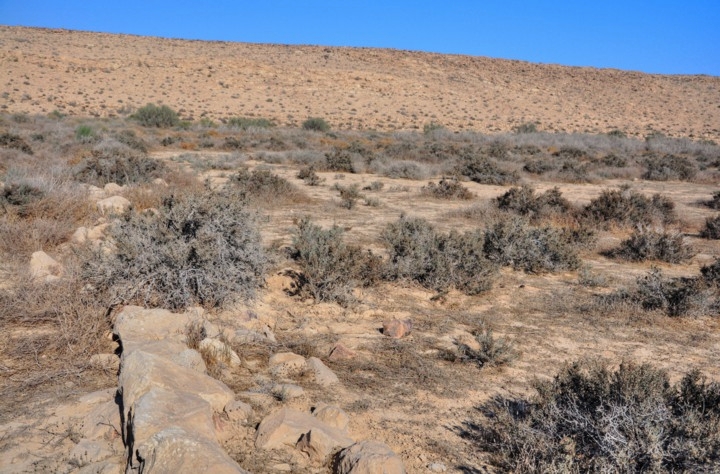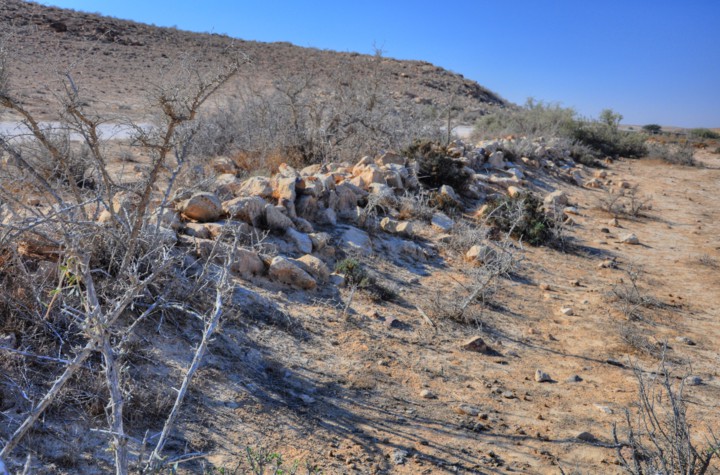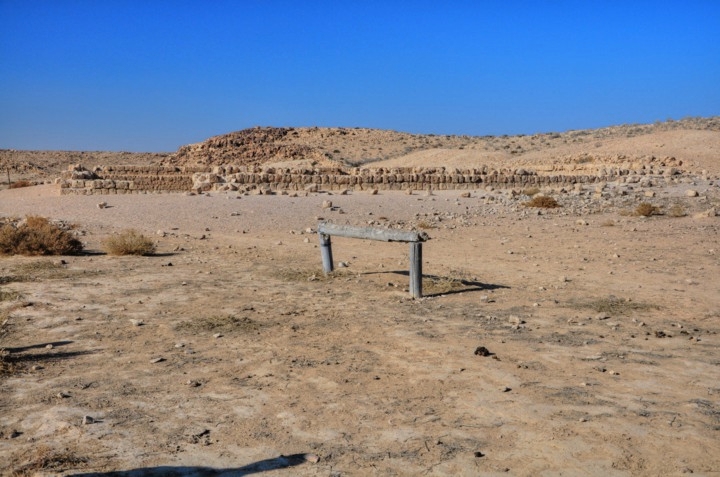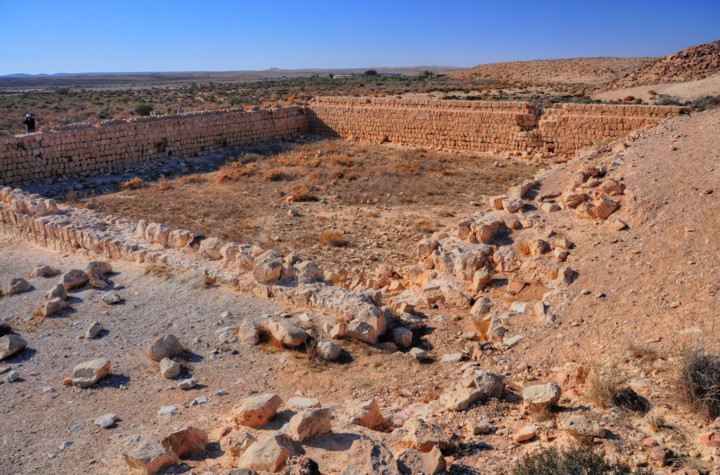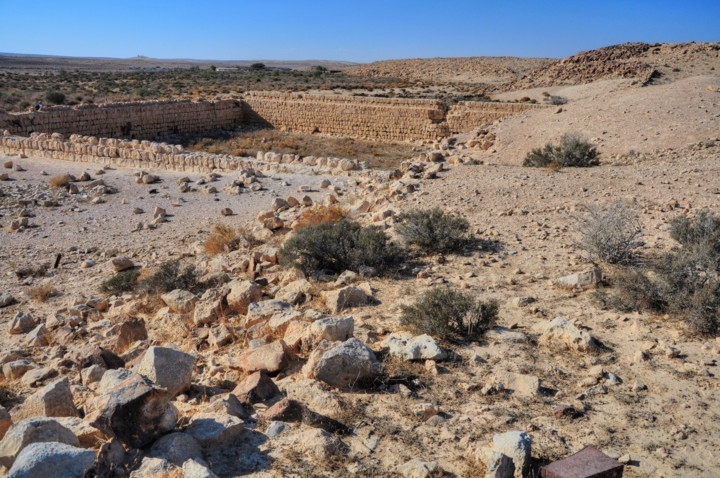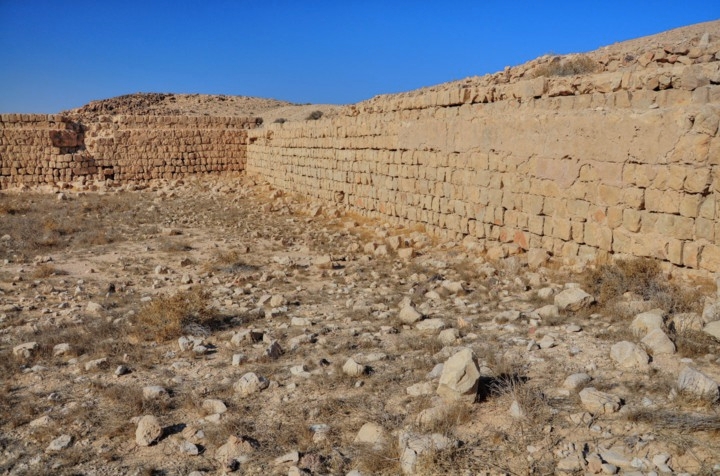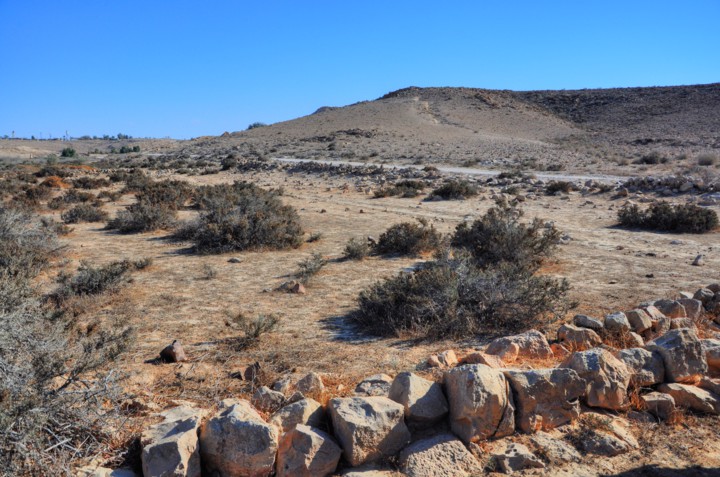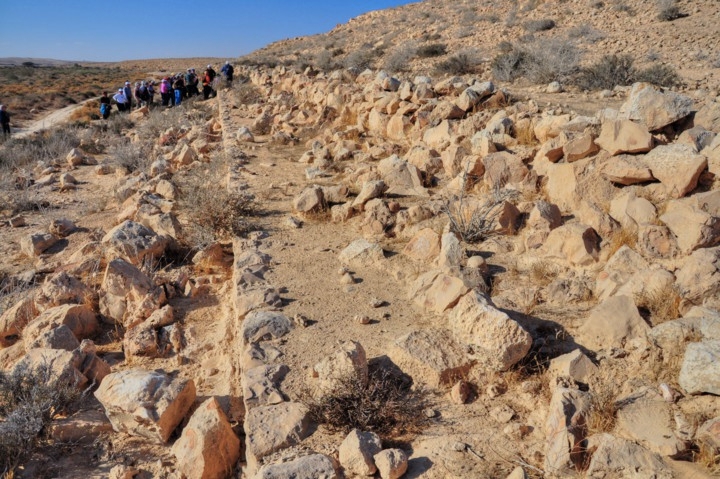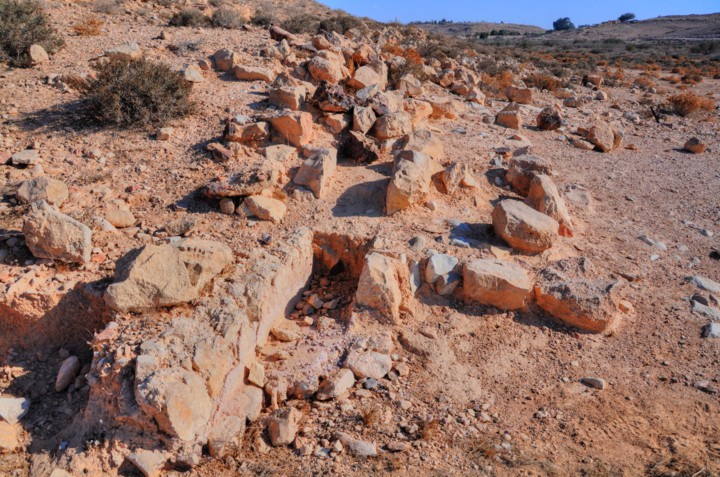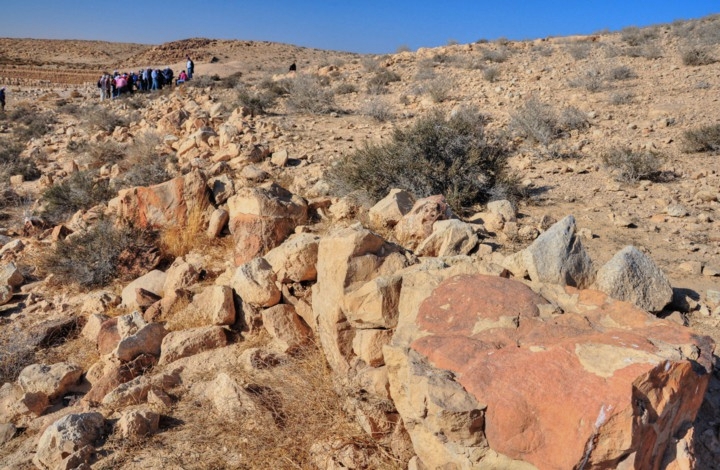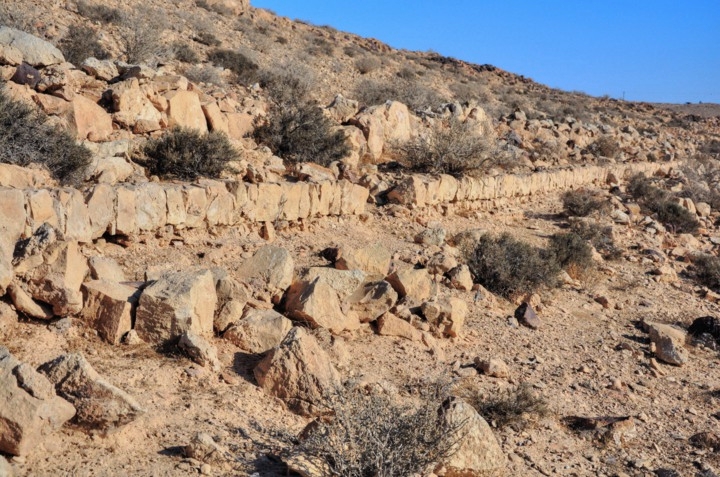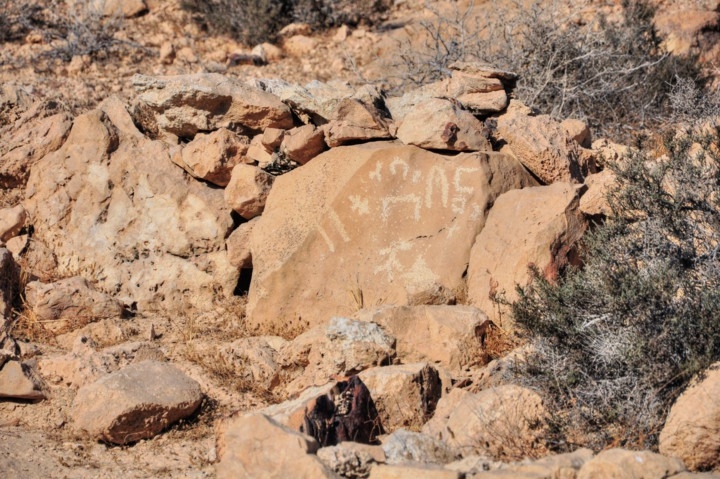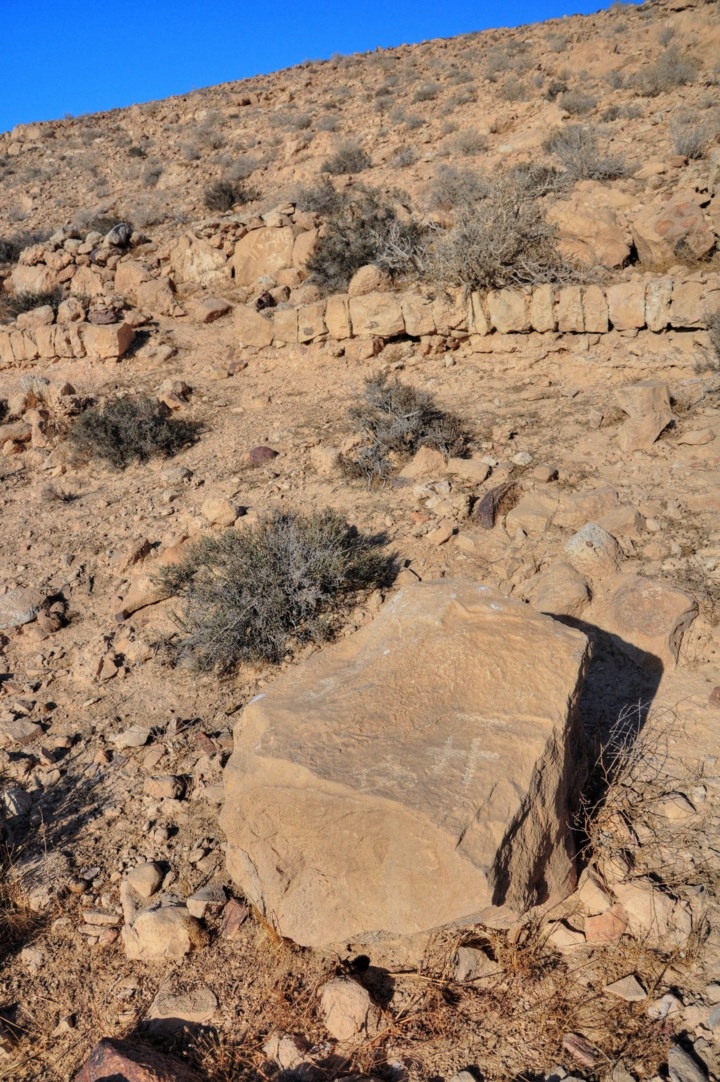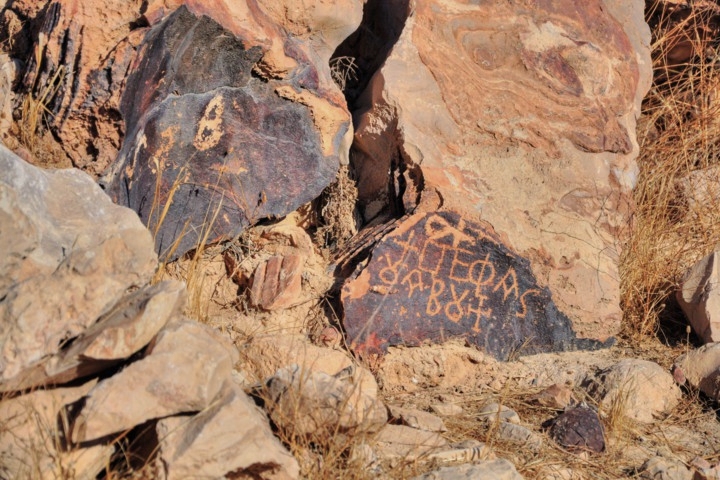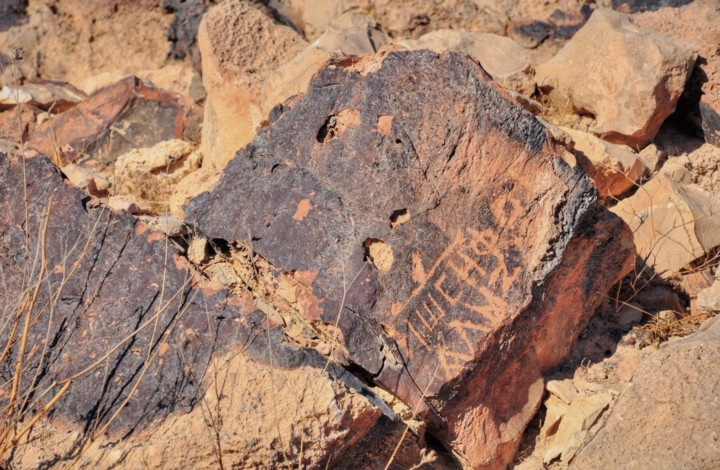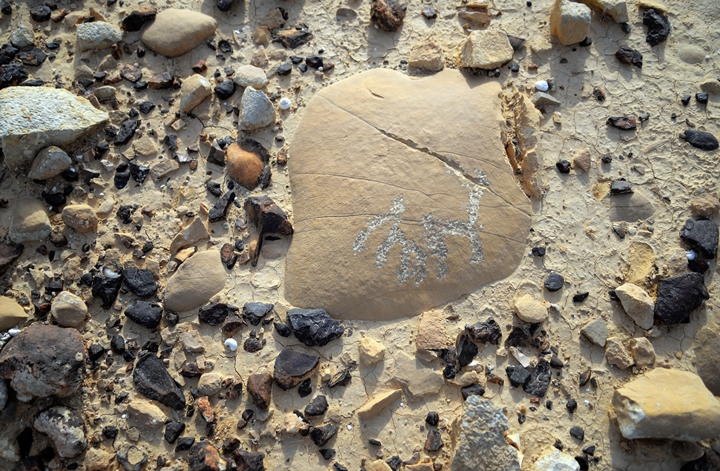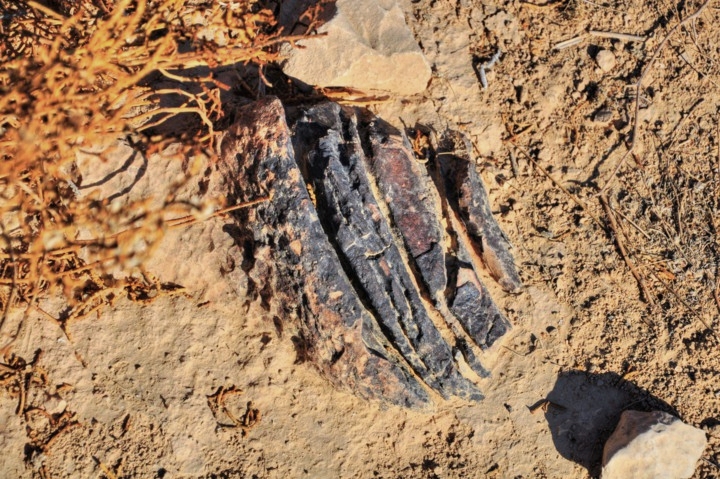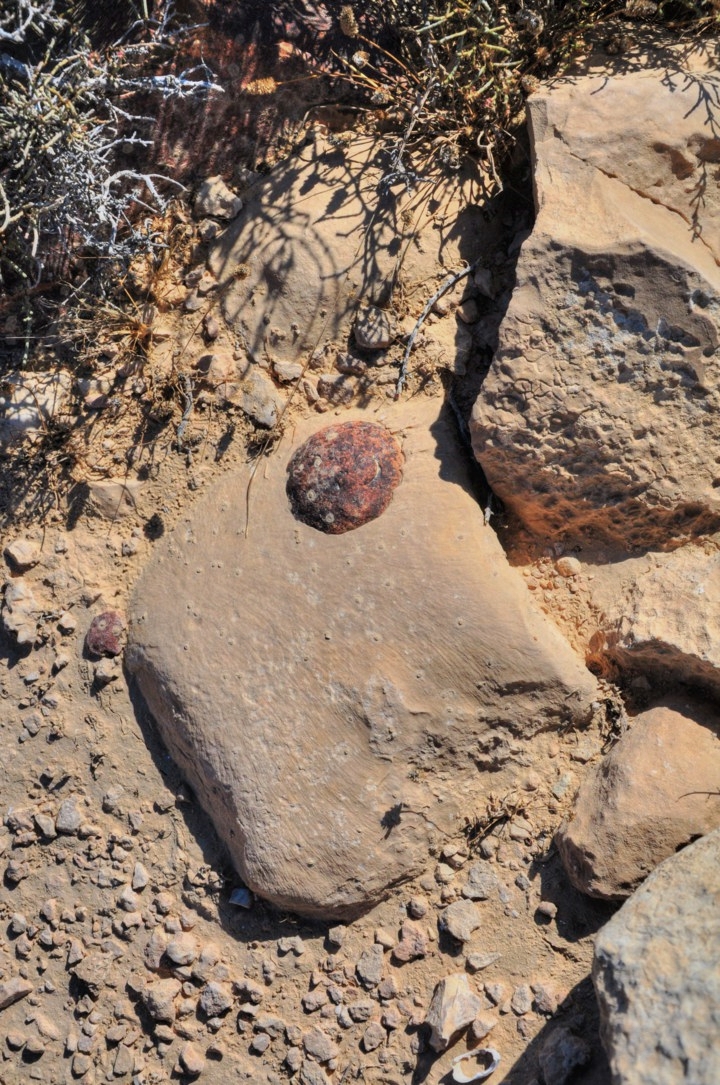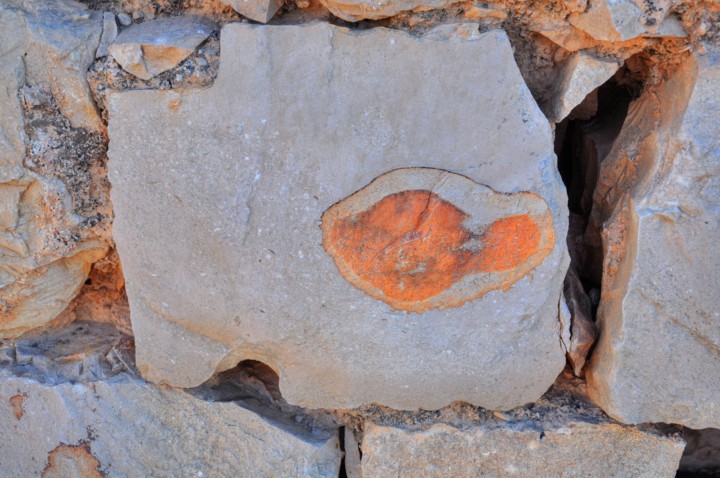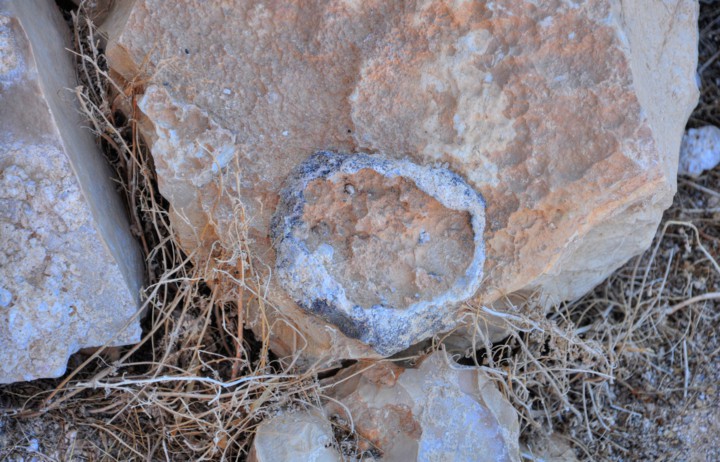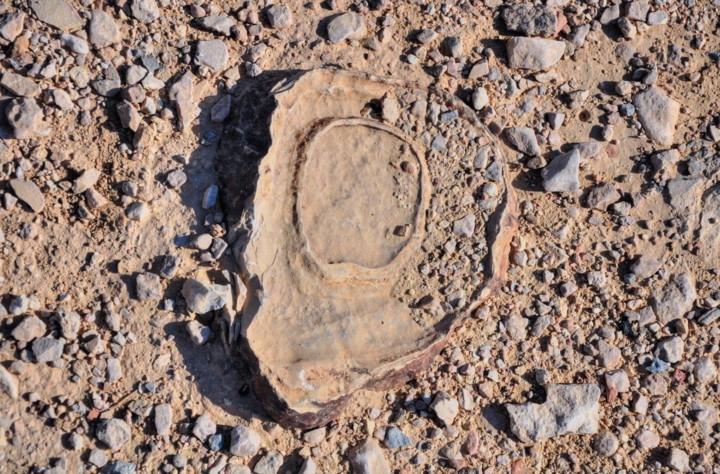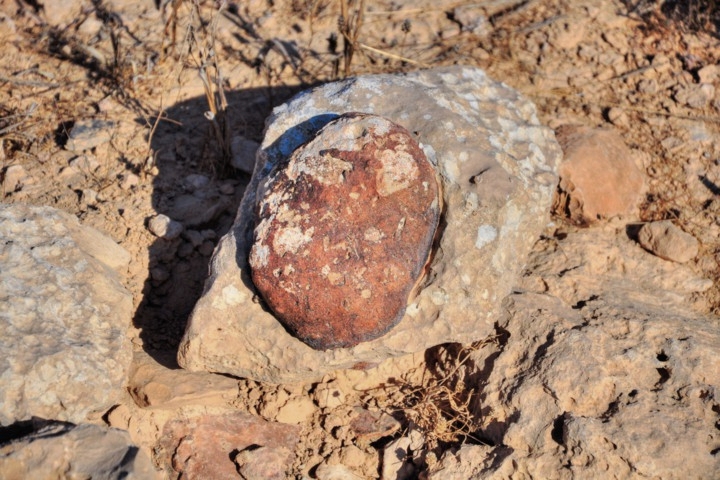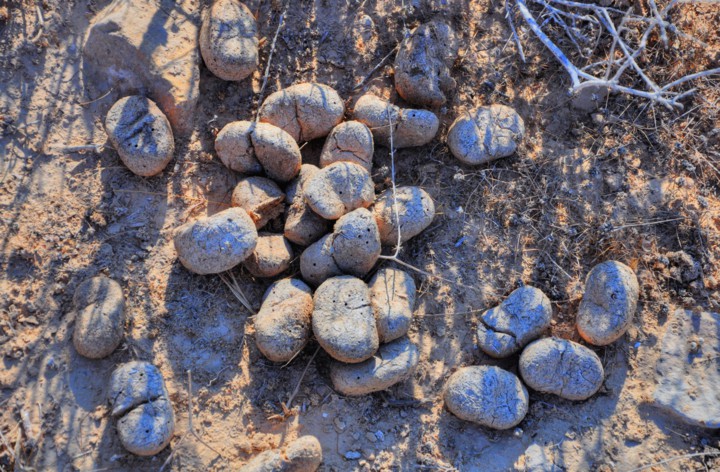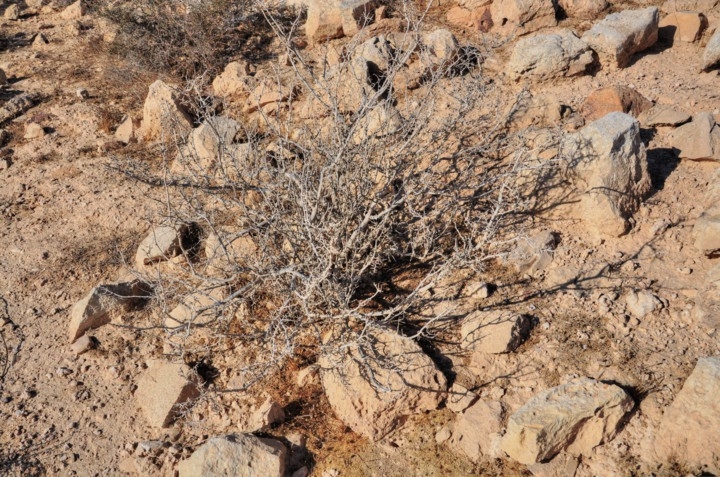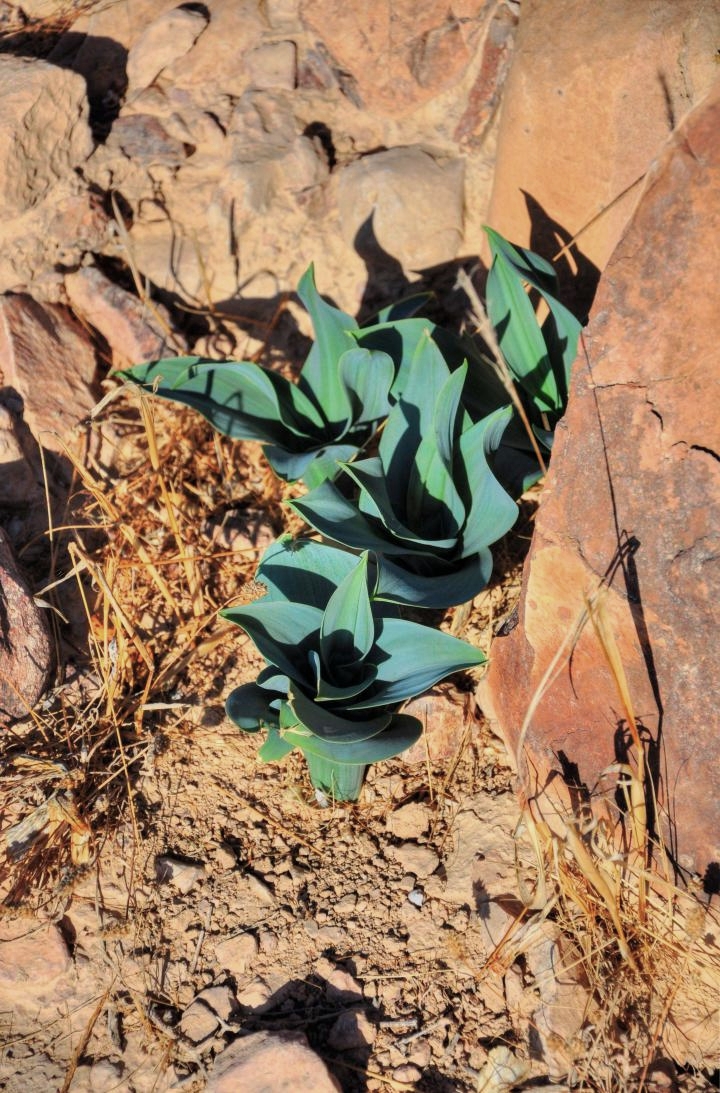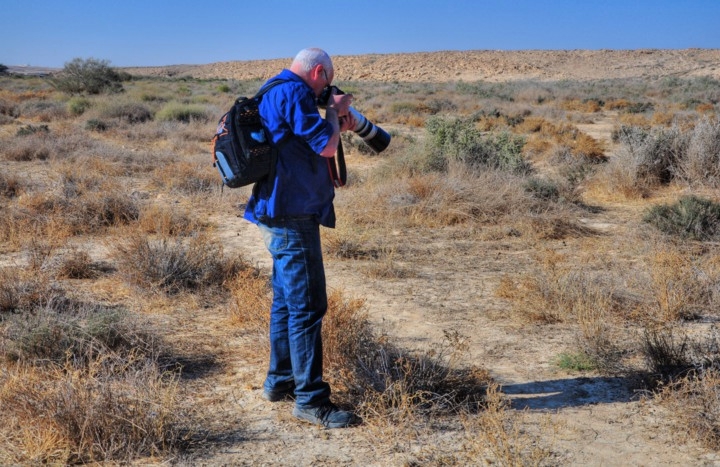A desert Oasis with two wells (named Moses and Aaron). Remains from the Bronze and Iron Age periods, Nabatean period, and Ottoman railway.
Home > Sites > Negev > Be’erotayim (Be’erota’im) – Two Wells, Ezuz
Contents:
Background
Location
History
Photos
* Oasis
* Fortress
* Railway
* Nabatean Farming
* Nabatean pool
* Aqueduct
* Engravings
* Rocks
* Plants
Biblical
Etymology
Links
Overview:
An oasis south of Nitzana, where its two wells (named after Moses and Aaron) gave the name of the place as “two wells”.
Deuteronomy 10:6: ” And the children of Israel took their journey from Beeroth of the children of Jaakan”.
Remains around the site include traces of prehistoric structures, Iron age and Persian period fortresses, Nabatean desert farming and water systems, and an Ottoman railway.
Location and aerial map:
The site is located 10km south of Nitzana, 3.3km east of the border with Egypt, 17km north-north-east of Kadesh-Barnea, 62km southwest of BeerSheba. The small community of Ezuz (“strong”) is located on the hill east of the oasis, at a height of 234m.
The aerial map shows the area, indicating the major sites.
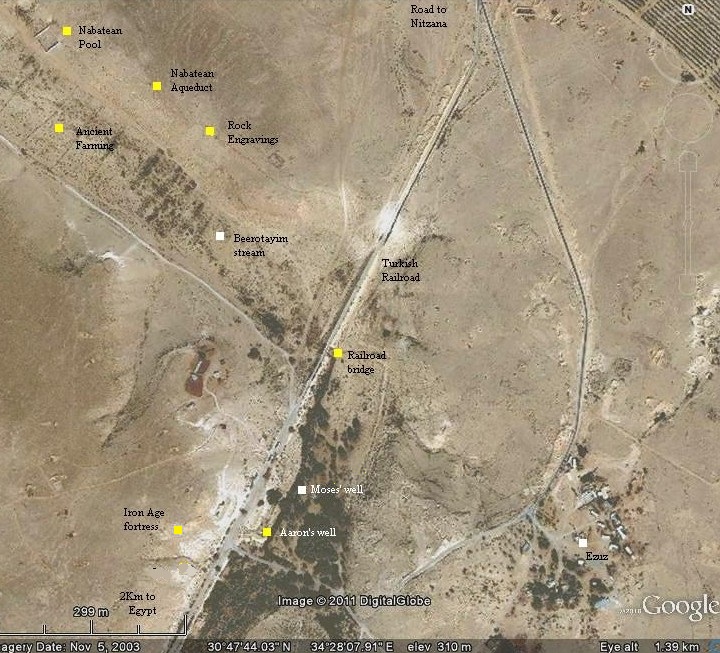
History:
- Prehistory
The oasis, with a year round water supply, attracted settlers from early times. Flintstone tools are scattered in the area around the site, evidence of a prehistoric settlement dated to the Middle and Upper Paleolithic periods (80,000 BC through 16,000 BC).
The site was was also settled during the Early and middle Bronze periods (31500-1550 BC). The area around Beerotayim witnessed a peak of settlement during the Middle Bronze I period (2200-2000 BC). According to the archaeological survey, remains of structures were identified on the eastern and western hills.
- Biblical period
The Biblical map below shows the region of the Negev desert during the period of the Exodus and the period of the Judges (16th-12th century BC). The site lies on the crossroads of two major ancient routes –
- North-East to South – Darb el-Shur ( “The way to Shur” – Beersheba to Kadesh-Barnea). This route is based on the Biblical name, described in the story of Hagar and Sara (Genesis 16: 7): “And the angel of the LORD found her by a fountain of water in the wilderness, by the fountain in the way to Shur.”. It is indicated as a dashed dark-grey line on the map.
- South-East to North-west – Darb el-Ghaza ( Aqaba/Eilat to Gaza). The southern side of this route is indicated as a light grey dashed line.
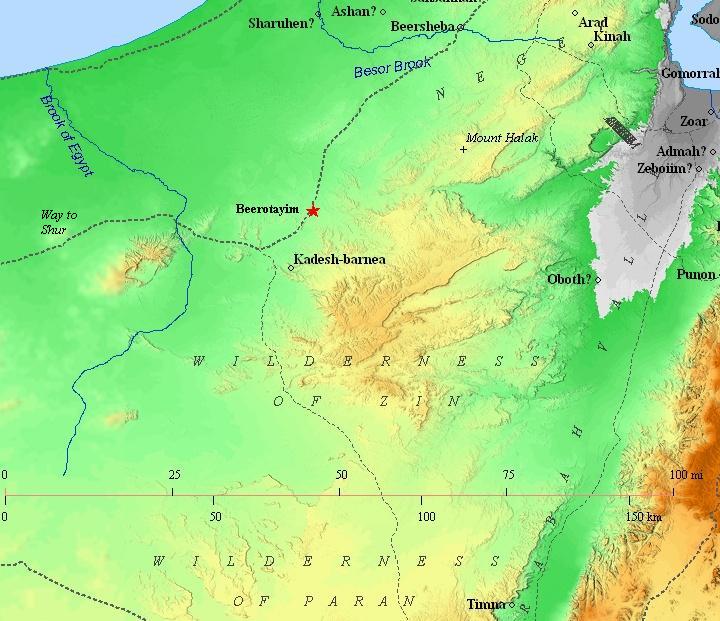
Map of the area around Be’erotayim – during the period of Exodus & Judges period, 16th century BC – 12th century BC (based on Bible Mapper 3.0)
- Exodus (about 14th century BC)
Kadesh Barnea, a large oasis located 17km to the south of Be’erotayim, was the southern border of the land of Canaan. Kadesh, blessed with many wells, was one of the major stations on the way from Canaan to Egypt. It was a site where Abraham dewlt (Genesis 20: 1): “And Abraham journeyed from thence toward the south country, and dwelled between Kadesh and Shur, and sojourned in Gerar”. Moses, Aaron and the Israelites passed through Kadesh and stayed there for a long time after escaping the Egyptian exile. According to the Bible (Deuteronomy 1 :46): “So ye abode in Kadesh many days, according unto the days that ye abode there”.
In Kadesh, Moses sent forth the 12 spies to prepare their entry back to Canaan (Numbers 13 :17): “And Moses sent them to spy out the land of Canaan”. The return of the spies is illustrated here. The spies probably passed through Be’erotayim.
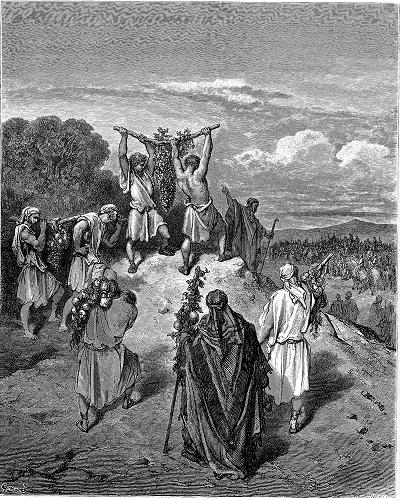
Return of the spies – Drawing by Gustav Dore (French artist, 1832-1883)
Following the path of the spies, the Israelites attempted to conquer Canaan from Kadesh, but this first attempt failed after the Canaanites blocked their way (Numbers 21: 1): “And when king Arad the Canaanite, which dwelt in the south, heard tell that Israel came by the way of the spies; then he fought against Israel, and took some of them prisoners”. As a result of this Canaanite resistance, the conquest plan changed, and the next attempt was conducted years later through Edom on the east.
- Israelite period – Iron Age (10th century BC)
After the Israelite conquest of Canaan, the area around Kadesh and Be’erotayim was within the inheritance of the tribe of Judah.
A fortress was located along the western hill overlooking the ancient route. It is dated to the Iron Age IIa period (1000-925 BC). The fortress includes a rectangular structure, a tower and residential rooms. This period is about the time of King David, who expanded the Kingdom beyond Kadesh. The southern border reached “the brook of Egypt” – 25km to the west of Be’erotayim.
In general, there was an unprecedented growth in the Negev area during the Iron age. The Bible writes about King Uzziah (2 Chronicles 26:10): “Also he built towers in the desert, and digged many wells: for he had much cattle, both in the low country, and in the plains”. The ancient desert farming techniques were probably invented during those times, and later perfected by the Nabateans.
- Persian period (6th-4th century BC)
On the western hill are remains of a fortress dated to the Persian period (539-332 BC).
- Late Ottoman period (20th century)
The Ottomans attempted to conquer the Suez canal from the British during WW1 (1914-1918). They supported this mission by laying out an extension to the western Hejaz railway section from Damascus to Afula, which was built in the years 1900-1908. This railway was extended to BeerSheba in 1915 and reached Nitzana and Be’erotayim in 1916, then was completed in Kuseima (Biblical Atzmon, 10km west of Kadesh). The design and management of the entire Hejaz railway project was commissioned to the German engineer Heinrich August Meisner. In Be’erotayim was a water refilling station for the railway.
- Modern Period (20th-21th century)
In 1956 a Kibbutz was established here on the border with Egypt, but abandoned in 1965. In 1985 a communal settlement was reestablished here.
An archaeological survey of the area of Be’erotayim (map 156) was conducted in 1996-1999 by Dr Tali Erickson-Gini.
The park of Be’erotayim is open free to the public, and come here for a short visit or overnight camping.
Photos:
(a) Oasis
The oasis of Be’erotayim is based on the abundance of water at this location. Two wells were dug here in ancient times, and are named after Moses and Aaron.
Click on the photos to view in higher resolution…
On the eastern hill are the houses of the modern communal settlement of Ezuz. On the hillside are several installations such as this old Turkish covered oven, where Bedouin women used to make bread for the Turkish soldiers stationed here during WW1. (Thanks for correction by Dr. Tali Erickson-Gini, who heard this from Alon Galilli).
“Aaron’s well” is located on the south side, while “Moses’ well” is on the north side of the oasis. The former well filled up a reservoir, seen below, which was used to supply water for the Ottoman trains that passed at this location on the way south. The impressive trees (Eshel, Tamarix aphylla) were planted in 1916 during the construction of the Ottoman railway and are 12m high.
On the foothills of the western hill are houses of one of the local desert guest houses. The community of Ezuz has several of guest houses (“zimmer”), including the unique desert guest house of Khan Be’erotayim (Ecotourism), located in the Be’erotayim stream (200m west of the Nabatean pool). It offers a hospitality mud house, meals based on local made materials, desert tours, camel rides and nature walks.
A number of ruined structures are scattered around, such as the one below which is located west of the Turkish railway bridge.
(b) Iron Age fortress
Ruins of a fortress are scattered along the edge of the western hill overlooking the ancient route. The fortress is dated to the Iron Age IIa period (1000-925 BC), and continued to be in use during the Persian period. R. Cohen excavated these ruins in 1986.
This photo was captured from the fortress, looking eastwards. The ancient route passed at the foot of the hill. The Ottoman railway passed here, cutting into the lower foothills. In the center of the view is the park that surrounds the two wells. The community of Ezuz, situated on a hill east of the park, is seen on the left background.
The complex covered an area of approximately 22x 24m, that included a courtyard in its north side, a central structure on the south west corner, and two rooms along the eastern side.
In its center is a raised structure 11.3m x 16.1m, with 0.7m wide walls. The structure includes 5 rooms arranged around a center space.Entrance to the structure was from the courtyard on the north side.
The fortress protected the trade route and the wells.
In the photo below – another view towards the flat area on the hill.
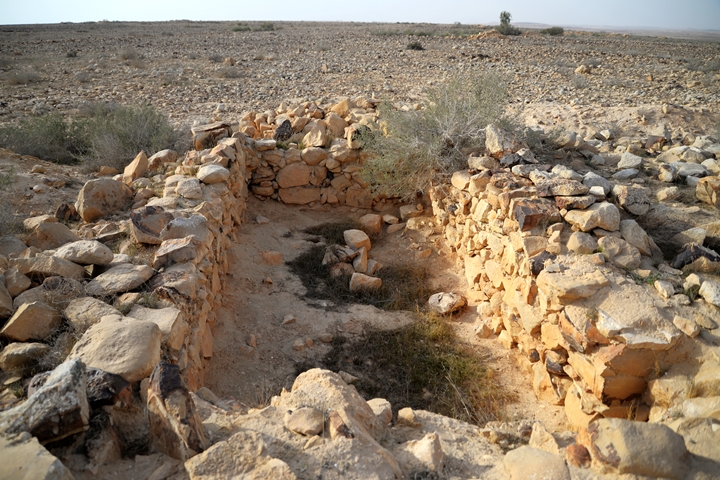
A tower on the southern edge of the hill overlooks the route towards the Sinai desert.
Uncle Itay stands here viewing the area.
(c) Turkish railway:
The Ottomans built this railway in 1916, connecting Kuseima, south of Be’erotayim, to the north (Damascus and beyond). A railway bridge over the Be’erotayim steam remained from that line. This view of the valley of Be’erotayim stream was taken from Ezuz, on the east side.
A closer view of the Ottoman bridge, which is in an excellent condition:
The modern road to Ezuz/Be’erotayim passes along the path of the railway:
(d) Nabatean desert Farming:
Along the stretch of the dry Be’erotayim stream are traces of the ancient Nabatean desert farming. During the Roman and Byzantine periods the Nabateans mastered the knowledge of collecting scarce desert water and using it for farming. They supplied fresh vegetables and fruits to the Nabatean cities, such as the nearby Nitzana, and to the army garrison stationed along the frontier. This desert farming started in the end of the 1st century AD and lasted until the 8th century.
The Nabateans built their farm lands along the narrow valleys (Wadis). The idea behind this was to collect the scarce rain water (only 200-300mm annual rainfall), and multiplying it by collecting the runoff into a smaller area where they would plant the crops.
These ancient farmers constructed stone walls, such as the one seen below, thus creating a series of dry lake sections. During the winter time, the rain water was collected from the hills around the farm land, and the water flooded these lakes, thus watering the crops.
As seen in the aerial view of the stream, at the top of this web page, the size of each farming section was roughly 250m in width (the size of the valley) by 120m (the distance between each separation wall). The total farming area of each section is 3 dunams (0.3 hectares). The researchers found that the ratio of the drainage basin for each such farming module was roughly 25 times larger, so each such section was watered by a drainage basin area of 75 dunams (7.5 hectares).
The Nabateans covered about 40,000-50,000 dunams (35,000 hectares) of farming area in the Negev area, out of a total of 2 million dunams (or, 2.5%). Most of the Negev farming was based on dryland farming (“Baal”) based on rainfall, while a minority of the agriculture was based on irrigated farming (“Shalkhin”).
(e) Nabatean Pool:
A large pool, dated to the Byzantine period, is located on the northern side of Be’erotayim (Ezuz) stream, about 800m north west of the railway bridge.
The Nabatean pool measures 28m by 41m, with a depth of 3m.
The pool is fed by an aqueduct, which is seen in the foreground of the following picture.
The north and western walls of the pool can be seen in the next photograph. The pool may have been covered with a wooden frame and a roof in order to reduce the evaporation of its water, but that has not been confirmed.
Then the water was transported from the reservoir to the fields along channels. One of these water channels is seen in the following photograph. The main aqueduct is seen stretching from right to left, and this water channel tapped off the aqueduct. The water supply supplemented the rain water which filled up the farming sections during the winter time.
(f) Nabatean Aqueduct:
Sections of the upper aqueduct, leading water into the pool, is seen along the north side of the Wadi, between the Nabatean pool and the two wells.
A cross section of the aqueduct can be seen below.
The total length of the aqueduct is 1400m. It collected rain water from the hills around the site, feeding into the pool, and then used to supply water to the fields.
Another view of the aqueduct:
(g) Rock Engravings:
About 400m to the south-east of the Nabatean pool are a number of rock engravings.They were carved in ancient times, by penetrating the dark patina crust, revealing a freshly exposed rock under the line.
This one has various crude illustrations:
Another rock near the aqueduct has two crosses:
Nearby, two Christian names are inscribed on dark, sun baked rocks. The first, in the following photo, has two crosses on both sides of the Greek inscription, and bears the name “Stephanus son of Wabus”.
Another Christian engraving is of “Yosef son of Almz”.
A larger number of rock engravings, including inscriptions and drawings, can be seen near the crossing of the streams Nahal Beerotayim and Nahal Takif, about 2km west of the Nabatean pool. An additional location is 3KM east of the pool.
Another rock engraving was spotted on the western hill, near the ancient fortress, with stick figures of 2 animals.
(h) Rocks:
Several interesting rocks and fossils can be seen all over the area. Here is a collection of some of them:
- Along Nahal Be’erota’im:
The next stones are actually … camel droppings.
- On the Fortress hill:
On the western hill, and actually in the whole area, are most amazing art forms crafted by nature. Many rocks were formed by a mix of dark and bright stones, carved in various shapes. This geological wonderland is a unique natural art museum.
The next rock consists of a special type of stones called Nummulites, fossils of marine single-celled organisms. They look like coins, and are named after them (based on the Latin form nummulus – means “little coin”). Inside the cluster rock are dozens of such coin shaped stones.The geological age of such fossils is of the Eocene geological epoch, from 56 to 33.9 million years ago.
Similar rocks with nummulites were published in Gilgal Argaman and Mt. Ebal.
(i) Desert Plants:
The desert is very dry here, with about 200mm annual raindrop. Although it is mid winter (January), there are no signs of any rain.
There are, though, some flowers that manage to survive the climate, and burst new leaves into a hopefully better winter.
In the photo below – Yechiel is taking close up pictures.
Biblical:
There are numerous Biblical verses naming a well.
Here is one associated with Moses and the Israelites, which was named simply “the well” (Beer in Hebrew):
Numbers 21:16-17: “And from thence they went to Beer: that is the well whereof the LORD spake unto Moses, Gather the people together, and I will give them water. Then Israel sang this song, Spring up, O well; sing ye unto it:”
Etymology (behind the name):
- Be’er – Hebrew: well.
- Be’erota’im, Be’erotayim – Hebrew: two wells.
- Bir Birein – Arabic name of the site (Bir=well).
- Bi’rain, Berain – Arabic: The two wells, the name appears in Nessana Papyri
- ‘Ezuz – Hebrew: strong. It is based on the Hebrew version of the Bible (Psalms 24:8): “Who is this King of glory? The LORD strong and mighty, the LORD mighty in battle.”. The name was translated from the Arabic name of Wadi Azizi.
- ‘Ezuz – communal settlement in Beeorotayim.
- Jaakan – This may have been the Biblical name of the two wells, a site where the Israelites passed during the 40 year exodus. Deuteronomy 10:6: ” And the children of Israel took their journey from Beeroth of the children of Jaakan to Mosera: there Aaron died, and there he was buried”.
Links:
* External links:
- Be’erotayim ecotourism
- IAA Survey – Map 156 Site 45 -Iron Age fortress (Hebrew)
- Mitzpe Ezuz – survey 2008 (IAA report, Hebrew, HA V126 2014) with many EB findings
- Nessana Papyri – People and identities (R. Stroumsa; pdf, 2008) – a cache of documents 505 AD-689 AD
- Meisner Pacha – pioneer of Railways (Hebrew, pdf)
* Other nearby BibleWalks Negev sites:
* Nabateans:
- Nabatean history (a BibleWalks page)
- Desert Agriculture – by Zohar Lapid (Hebrew, pdf)
* Rock art:
- Rock Art of the Central Negev – Davida Eisenberg Degen (pdf; pp 386; 2012) – http://aranne5.bgu.ac.il >DegenDavidaEisenberg3.pdf
* Other related BibleWalks sites:
BibleWalks.com – Ancient wonders in the Negev desert
Shivta <—previous site—<<<All Sites>>>—next Negev site—> Nitzana
This page was last updated on May 21, 2021 (Iron Age fortress; add rocks)
Sponsored links:
